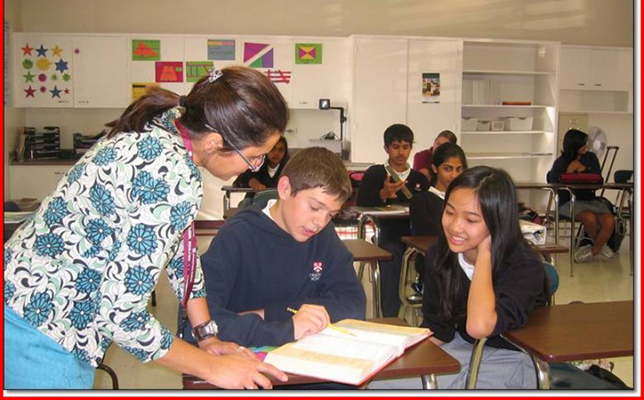Playbook Shows How to Redesign K–12 Schools for 21st Century Learning
- By Dian Schaffhauser
- 05/26/17

Students and a teacher at Burnett Middle School in San Jose, CA.
In the heart of Silicon Valley exists a public school with 850 students in grades 6 through 8. Almost nine in 10 students (89 percent) are eligible for free and reduced-price lunch, 83 percent identify as Hispanic and 51 percent are English language learners. If demographics alone defined the school, you might expect three in 10 students to drop out of high school and just a little more than a handful to go on to graduate from college. Yet Burnett Middle School is defying the odds.
The San Jose, CA school increased its state Academic Performance Index from 654 in 2009 to 740 by 2014, blowing away the growth rates of similar schools.
How Burnett achieved its redesign makes up the appendix of a new playbook intended for school leaders who want lessons in how to redesign their schools for 21st century success as well. The report — all 170 pages of it — was produced by Cross & Joftus, a consulting firm that works with districts, foundations, nonprofits and others to help them meet education goals.
In 2012, the San Jose Unified School District, of which Burnett is a part, piloted a redesign competition to jumpstart new school models within the district. The initiative received support from the William and Flora Hewlett Foundation, the Silicon Valley Community Foundation, the Institute for the Future and Enterprise Development Group. Along with extra resources (such as, at Burnett, a major update of its technology), schools whose proposals were accepted also received coaching and implementation support from Cross & Joftus.
"Playbook for Redesigning Schools for the 21st Century" consists of two main parts. The first part offers a step-by-step process for redesign, including how to develop a "shared vision" for transformation, identify relevant stakeholders, create goals and action plans and run meetings. The second part offers tools and other resources to be used by the redesign team as they need them during the makeover process.
"At its core," the report's authors wrote, "a school redesign is a complex change management process. It is challenging work that requires a shared vision, a clear understanding of goals and action steps, and the collective time and effort of the whole school community. The importance of implementing a thoughtful, well-organized redesign plan tailored to your school’s needs — and attending fully to each step in the process — cannot be overstated. The good news is that your redesign vision is not only worth the effort, it’s also possible to achieve."
"Redesigning a school was the most challenging and stressful — but rewarding — experience of my career,” said Lisa Aguerria Lewis, Burnett's principal from 2006 to 2015. “The challenges came in many forms — from developing a detailed plan, implementing it alongside all of the other work associated with running a school, and managing a group of people through a change process."
But the work of the redesign was worth it, Lewis added. "Knowing that what we were doing was making a difference for students and their future was the ultimate honor."
The playbook is freely available on the Cross & Joftus website here.
About the Author
Dian Schaffhauser is a former senior contributing editor for 1105 Media's education publications THE Journal, Campus Technology and Spaces4Learning.